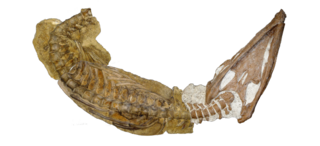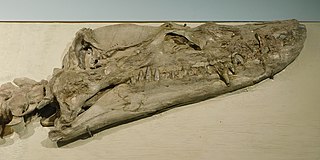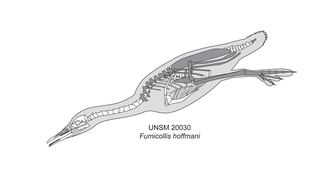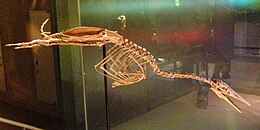
Hesperornithes is an extinct and highly specialized group of aquatic avialans closely related to the ancestors of modern birds. They inhabited both marine and freshwater habitats in the Northern Hemisphere, and include genera such as Hesperornis, Parahesperornis, Baptornis, Enaliornis, and Potamornis, all strong-swimming, predatory divers. Many of the species most specialized for swimming were completely flightless. The largest known hesperornithean, Canadaga arctica, may have reached a maximum adult length of 2.2 metres (7.2 ft).

Ichthyornis is an extinct genus of toothy seabird-like ornithuran from the late Cretaceous period of North America. Its fossil remains are known from the chalks of Alberta, Alabama, Kansas, New Mexico, Saskatchewan, and Texas, in strata that were laid down in the Western Interior Seaway during the Turonian through Campanian ages, about 95–83.5 million years ago. Ichthyornis is a common component of the Niobrara Formation fauna, and numerous specimens have been found.

Hesperornis is a genus of cormorant-like Ornithuran that spanned throughout the Campanian age, and possibly even up to the early Maastrichtian age, of the Late Cretaceous period. One of the lesser-known discoveries of the paleontologist O. C. Marsh in the late 19th century Bone Wars, it was an early find in the history of avian paleontology. Locations for Hesperornis fossils include the Late Cretaceous marine limestones from Kansas and the marine shales from Canada. Nine species are recognised, eight of which have been recovered from rocks in North America and one from Russia.

The Tylosaurinae are a subfamily of mosasaurs, a diverse group of Late Cretaceous marine squamates. Members of the subfamily are informally and collectively known as "tylosaurines" and have been recovered from every continent except for South America. The subfamily includes the genera Tylosaurus, Taniwhasaurus, and Kaikaifilu, although some scientists argue that only Tylosaurus and Taniwhasaurus should be included.

Protosphyraena is a fossil genus of swordfish-like marine fish, that thrived worldwide during the Cretaceous period (Albian-Maastrichtian). Fossil remains of this taxon are mainly discovered in North America and Europe, and potential specimens are also known from Asia, Africa and Australia. Its fossils are best known from the Smoky Hill Member of the Niobrara Chalk Formation of Kansas.

Nyctosaurus is a genus of nyctosaurid pterosaur from the Late Cretaceous period of what is now the Niobrara Formation of the mid-western United States, which, during the time Nyctosaurus was alive, was covered in an extensive shallow sea. Some remains belonging to a possible Nyctosaurus species called "N." lamegoi have been found in Brazil, though it likely belongs to a different genus Simurghia. The genus Nyctosaurus has had numerous species referred to it, though how many of these may actually be valid requires further study. At least one species possessed an extraordinarily large antler-like cranial crest.

Protostega is an extinct genus of sea turtle containing a single species, Protostega gigas. Its fossil remains have been found in the Smoky Hill Chalk formation of western Kansas, time-equivalent beds of the Mooreville Chalk Formation of Alabama and Campanian beds of the Rybushka Formation. Fossil specimens of this species were first collected in 1871, and named by Edward Drinker Cope in 1872. With a total length of 3.9 metres (13 ft), it is the second-largest sea turtle that ever lived, second only to the giant Archelon, and one of the three largest turtle of all time along Archelon and Gigantatypus.

Baptornis is a genus of flightless, aquatic birds from the Late Cretaceous, some 87-80 million years ago. The fossils of Baptornis advenus, the type species, were discovered in Kansas, which at its time was mostly covered by the Western Interior Seaway, a shallow shelf sea. It is now known to have also occurred in today's Sweden, where the Turgai Strait joined the ancient North Sea; possibly, it occurred in the entire Holarctic.
Polarornis is a genus of prehistoric bird, possibly an anserimorph. It contains a single species Polarornis gregorii, known from incomplete remains of one individual found on Seymour Island, Antarctica, in rocks which are dated to the Late Cretaceous.

Dolichorhynchops is an extinct genus of polycotylid plesiosaur from the Late Cretaceous of North America, containing the species D. osborni and D. herschelensis, with two previous species having been assigned to new genera. Definitive specimens of D. osborni have been found in the late Coniacian to early Campanian rocks, while those of D. herschelensis have been found in the late Campanian to early Maastrichtian rocks. Dolichorhynchops was a prehistoric marine reptile measuring around 3 metres (9.8 ft) long. Its Greek generic name means "long-nosed face".

Brachauchenius is an extinct genus of pliosaurs that lived during the Late Cretaceous in what are now North America and North Africa. Only one species is known, B. lucasi, initially described by Samuel Wendell Williston in 1903 from a partial fossil skeleton discovered in a quarry in Kansas, United States. Many other fossil specimens attributed to the species were subsequently discovered, including an individual from Morocco whose presence was made official in 2016. Many contemporary pliosaur specimens were formerly attributed to Brachauchenius, but have since been reidentified as belonging to other genera or are recognized as indeterminate.
Neogaeornis is a controversial prehistoric genus of diving bird. The single known species, Neogaeornis wetzeli, was described from fossils found in the Campanian to Maastrichtian Quiriquina Formation of Chile. It lived about 70-67 million years ago. It remains known from the single tarsometatarsus described in 1929 by Lambrecht, and today housed in the Paläontologisches Institut und Museum in Kiel, Germany.

Apatornis is a genus of ornithuran dinosaurs endemic to North America during the late Cretaceous. It currently contains a single species, Apatornis celer, which lived around the Santonian-Campanian boundary, dated to about 83.5 million years ago. The remains of this species were found in the Smoky Hill Chalk of the Niobrara Formation in Kansas, United States. It is known from a single fossil specimen: a synsacrum, the fused series of vertebrae over the hips.
Canadaga is a flightless bird genus from the Late Cretaceous. The single known species is Canadaga arctica. It lived in the shallow seas around what today is Bylot and Devon Islands in Nunavut, Canada. Its fossils were found in rocks dated to the Campanian to mid-Maastrichtian age, about 67 million years ago.

Styxosaurus is a genus of plesiosaur of the family Elasmosauridae. Styxosaurus lived during the Campanian age of the Cretaceous period. Three species are known: S. snowii, S. browni, and S. rezaci.

During the time of the deposition of the Niobrara Chalk, much life inhabited the seas of the Western Interior Seaway. By this time in the Late Cretaceous many new lifeforms appeared such as mosasaurs, which were to be some of the last of the aquatic lifeforms to evolve before the end of the Mesozoic. Life of the Niobrara Chalk is comparable to that of the Dakota Formation, although the Dakota Formation, which was deposited during the Cenomanian, predates the chalk by about 10 million years.

Pteranodontoidea is an extinct clade of ornithocheiroid pterosaurs from the Early to Late Cretaceous of Asia, Africa, Europe, North America and South America. It was named by Alexander Wilhelm Armin Kellner in 1996. In 2003, Kellner defined the clade as a node-based taxon consisting of the last common ancestor of Anhanguera, Pteranodon and all its descendants. The clade Ornithocheiroidea is sometimes considered to be the senior synonym of Pteranodontoidea, however it depends on its definition. Brian Andres in his analyses, converts Ornithocheiroidea using the definition of Kellner (2003) to avoid this synonymy.

This timeline of plesiosaur research is a chronologically ordered list of important fossil discoveries, controversies of interpretation, taxonomic revisions, and cultural portrayals of plesiosaurs, an order of marine reptiles that flourished during the Mesozoic Era. The first scientifically documented plesiosaur fossils were discovered during the early 19th century by Mary Anning. Plesiosaurs were actually discovered and described before dinosaurs. They were also among the first animals to be featured in artistic reconstructions of the ancient world, and therefore among the earliest prehistoric creatures to attract the attention of the lay public. Plesiosaurs were originally thought to be a kind of primitive transitional form between marine life and terrestrial reptiles. However, now plesiosaurs are recognized as highly derived marine reptiles descended from terrestrial ancestors.

Tingmiatornis is a genus of flighted and possibly diving ornithurine dinosaur from the High Arctic of Canada. The genus contains a single species, T. arctica, described in 2016, which lived during the Turonian epoch of the Cretaceous.

Fumicollis is a genus of prehistoric flightless birds from the Late Cretaceous (Coniacian-Santonian) Niobrara Chalk of Kansas.




























